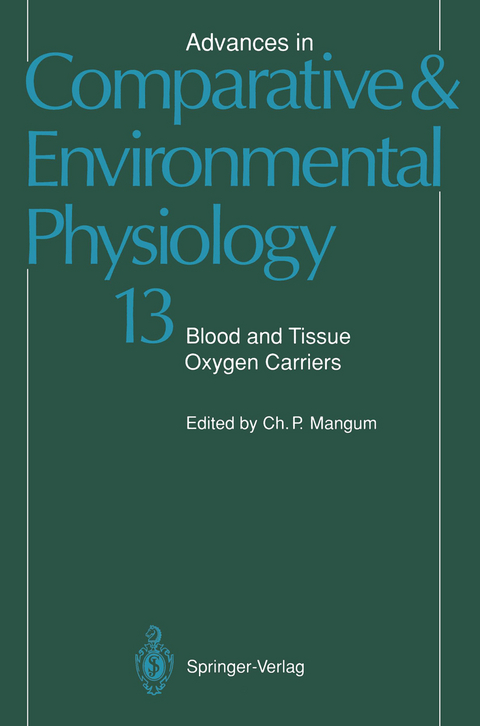
Blood and Tissue Oxygen Carriers
Springer Berlin (Verlag)
978-3-642-76420-2 (ISBN)
1 Oxygen Carriers as Molecular Models of Allosteric Behavior.- 1 Introduction and Outline.- 2 Properties of Respiratory Proteins.- 3 Features and Properties of Allosteric Proteins.- 4 Derivation of Oxygen-Saturation Functions: The Generating Function.- 5 Oxygen Binding by Human Hemoglobin.- 6 Oxygen Binding by High Molecular Weight Invertebrate Hemoglobins.- 7 Oxygen Binding by Arthropod Hemocyanins.- 8 Oxygen Binding by Molluscan Hemocyanins.- 9 Concluding Remarks.- References.- 2 Plant Hemoglobins.- 1 Introduction.- 2 Distribution and Physiological Function of Plant Hemoglobins.- 3 Structures and Reactions of Plant Hemoglobins.- 4 Biosynthesis and Degradation of Plant Hemoglobins.- References.- 3 Functions of Cytoplasmic Hemoglobins and Myohemerythrin.- 1 Structure.- 2 Function of Cytoplasmic Hemoglobin and Myohemerythrin at High Concentration: Hemoglobin-Facilitated Oxygen Diffusion.- 3 Functions of Cytoplasmic Hemoglobin at Low Concentration: Myoglobin-Mediated Oxidative Phosphorylation.- 4 Hemoglobin as a Terminal Oxidase.- 5 Hemoglobin-Associated Iron.- 6 Oxygen Storage in Large Domains: The Insect Tracheal Organ.- 7 Oxygen Storage in Very Small Domains.- 8 Nerve Hemoglobins.- 9 Nematode and Trematode Hemoglobins.- 10 Hemoglobin-Mediated Sulfide Utilization.- 11 Summary.- 12 Conclusion.- References.- 4 Structures of Red Blood Cell Hemoglobins.- 1 Introduction.- 2 Invertebrate Hemoglobins.- 3 Vertebrate Hemoglobins.- 4 Conclusions.- References.- 5 Respiratory Function of the Red Blood Cell Hemoglobins of Six Animal Phyla.- 1 Introduction.- 2 RBC Distribution, Hematology, and Morphology.- 3 Respiratory Design.- 4 O2 Binding of RBCs and Purified Hb Components.- 5 Respiratory Functions of RBC Hbs.- 6 Evolution of the RBC.- References.- 6 Molecular Structure/Function Relationships of Hemerythrins.- 1 Introduction.- 2 Structure of the Protein.- 3 Structure of the Diiron Site and O2-Binding Properties.- 4 Allosteric Effectors and Cooperativity in O2 Binding.- 5 Comparisons to O2 Binding in Myoglobin/Hemoglobin and Hemocyanin.- 6 Redox Chemistry of the Diiron Site.- 7 An Unexamined Problem: Protein Folding and Iron Site Assembly.- 8 Relationships to Nonheme Diiron Sites in Other Proteins.- References.- 7 Physiological Function of the Hemerythrins.- 1 Introduction.- 2 Respiratory Design of Hemerythrin-Containing Animals.- 3 In Vitro Respiratory Properties.- 4 In Vivo Respiratory Properties.- 5 Physiological Significance of the Temperature Dependence of the Hemerythrins.- 6 Conclusions.- References.- 8 Molecular Structure of the Extracellular Heme Proteins.- 1 Introduction.- 2 Annelid Extracellular Hemoglobins.- 3 Annelid Extracellular Chlorocruorins.- 4 Pogonophore and Vestimentiferan Extracellular Hemoglobins.- 5 Nematode Extracellular Hemoglobins.- 6 Arthropod Extracellular Hemoglobins.- 7 Molluscan Extracellular Hemoglobins.- 8 Biosynthesis of Invertebrate Hemoglobins.- 9 Conclusions.- References.- 9 Properties and Functions of Extracellular Heme Pigments.- 1 Introduction.- 2 Distribution and Localization.- 3 Oxygen-Binding Properties.- 4 Functions of Extracellular Heme Pigments.- 5 Transport, Transfer, and Storage Functions.- 6 Other Functions.- 7 Summary and Conclusion.- References.- 10 Molluscan Hemocyanins: Structure and Function.- 1 Introduction: The Nature and Distribution of Molluscan Hemocyanins.- 2 Structure of the Native Molluscan Hemocyanin Molecule.- 3 Subunits of Molluscan Hemocyanins.- 4 Primary Structure and Evolution of Molluscan Hemocyanins.- 5 The Active Site and Oxygen Binding.- References.- 11 Respiratory Functionof the Molluscan Hemocyanins.- 1 Distribution and Phylogeny of the Molluscan Hemocyanins.- 2 Molecular Size and Structure.- 3 Oxygen-Carrying Capacity of Molluscan Bloods.- 4 Oxygen Equilibrium Properties of Molluscan Hemocyanins.- 5 Physiological Functioning of the Molluscan Hcs.- 6 Summary and Conclusions.- References.- 12 Molecular Structure of the Arthropod Hemocyanins.- 1 Introduction.- 2 The Quaternary Structure.- 3 On the Relationship Between Structure and Function.- 4 Heterogeneity of the Subunits.- 5 Molecular Structure of the Subunit and the Hexamer.- 6 Biosynthesis.- 7 Evolution.- References.- 13 Respiratory Function of Arthropod Hemocyanins.- 1 Introduction.- 2 Hemolymph Oxygen-Binding Properties.- 3 Oxygen Transport: The Functioning of Hemocyanin in Vivo.- 4 Modulation of Hemocyanin O2-Carrying Function.- References.- 14 Structure-Function Relationships of the Ectothermic Vertebrate Hemoglobins.- 1 Introduction.- 2 Hemoglobins of the Agnatha.- 3 Hemoglobin Heterogeneity.- 4 Root Effect Hemoglobins.- 5 Changes in Hemoglobins During Ontogeny.- 6 Methemoglobin.- 7 Summary.- References.- 15 Respiratory Functions of Avian and Mammalian Hemoglobins.- 1 Introduction.- 2 Oxygen Capacity of Blood.- 3 The Affinity of Hemoglobin for Oxygen - Whole Blood.- 4 Cooperativity of Oxygen Binding.- 5 The Bohr Effect in Whole Blood.- 6 Molecular Basis for Differences in Respiratory Properties of Hb.- 7 Modulation of the Respiratory Functions of Hb.- References.
| Erscheint lt. Verlag | 6.12.2011 |
|---|---|
| Reihe/Serie | Advances in Comparative and Environmental Physiology |
| Co-Autor | M. Brouwer, H. Decker, W.H. Fuchsman, R.L. Ingermann, D.M. Kurtz Jr., W.H. Lang, Charlotte P. Mangum, J. Markl, K.I. Miller, W.E. Royer Jr., G.K. Snyder, N.B. Terwilliger, A. Toulmond, J.P. Truchot, K.E. van Holde, J.B. Wittenberg |
| Mitarbeit |
Gast Herausgeber: Charlotte P. Mangum |
| Zusatzinfo | XVIII, 459 p. |
| Verlagsort | Berlin |
| Sprache | englisch |
| Maße | 155 x 235 mm |
| Gewicht | 720 g |
| Themenwelt | Studium ► 1. Studienabschnitt (Vorklinik) ► Physiologie |
| Naturwissenschaften ► Biologie ► Biochemie | |
| Naturwissenschaften ► Biologie ► Zoologie | |
| Schlagworte | Agnatha • animals • Atmung • blood cell • Blut • Chemistry • Evolution • Hämocyanin • Hämoerythrin • Hämoglobin • hemocyanin • hemoerythrin • hemoglobin • Mammalia • Mollusca • Morphology • phosphorylation • primary structure • Protein • Protein Folding • respiration • Sauerstofftransport • synthesis • tissue |
| ISBN-10 | 3-642-76420-7 / 3642764207 |
| ISBN-13 | 978-3-642-76420-2 / 9783642764202 |
| Zustand | Neuware |
| Haben Sie eine Frage zum Produkt? |
aus dem Bereich


